|
This section contains 4,335 words (approx. 15 pages at 300 words per page) |

|
An important feature of African religions, both historically and in the twenty-first century, has been the interpretation of adversity within the framework of cults, or specialized therapeutic communities. Although cults concerned with affliction and healing are widespread on the continent, the technical term cults of affliction has been used in scholarship specifically to describe the healing cults found among the Bantu-speaking peoples of central and southern Africa. The two major criteria of such cults are spirit possession and the initiation of the afflicted person into the cult. These cults have also been called "drums of affliction" because of the significance in their rituals of drums and rhythmic song dancing, both termed ngoma ("drum"), over a wide area. Also important in this context is the elongated ngoma-type single-membrane drum, which plays a central role in rituals throughout the region. The importance of...
|
This section contains 4,335 words (approx. 15 pages at 300 words per page) |

|



